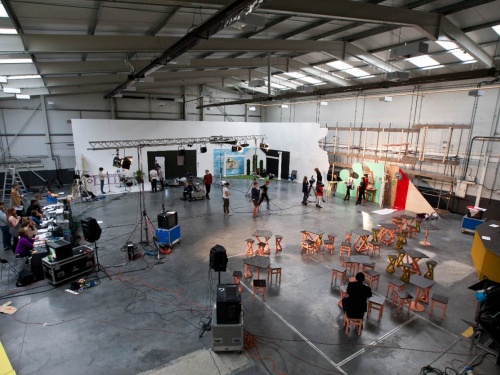Interview with Writer and Producer Yair Oelbaum on There We Will Be Buried
Announcing the start of our new partnership, LIFT and ICA present There We Will Be Buried, a theatrical production with a cast including the renowned German artist Kai Althoff, running 21-24 June 2012. On Thursday 21 June we're also hosting a book launch event for a publication documenting the production in an edition of 1,000 at a special launch price of £6.00.
This unique play is is a visual arts response to the performing arts written and produced by Yair Oelbaum. We asked him a few questions...
ICA: How did the idea to create There we will be buried come about?
Yair Oelbaum: In the summer of 2010 Kai Althoff had asked me to write a play that we would both be able to perform in. Originally we thought the piece would be performed in the basement of a nightclub in Manhattan. Before I even began writing the piece, Kai was approached by Saim Demircan of Focal Point Gallery in Southend-On-Sea who suggested that the piece be performed in Southend’s Palace Theater instead. This allowed for There we will be buried to be developed as a much more elaborate piece.
The initial idea for the piece came from a film that I had made in August 2009 called The Name. The audio recording that we had made while shooting the film was unfortunately misplaced by a member of our crew. I then had no choice but to re-record the sound to accompany the original footage. I attempted to create a purposefully out-of-sync sound recording; the images told a story captured on top of a mountain. The sound told a story captured in my living room, providing a slight illusion of insularity and domesticity within wilderness. I was enthralled by the divergent meanings that this pairing suggested, and the manner in which both parts of the piece continually thwarted the narrative authority of the other.
A live performance of this nature seemed like an even more fitting space to apply this constraint – the visceral, physical acts of the performers are continually reconsidered by the words that the voice-over suggests that they are saying. The same can be said of the performers, whose actions and expression suggest alternate accounts slightly (and occasionally vastly) contrasting the tone and content of the recording. The characters meekly attempt to develop the agency to stray from the impressed narrative of the voice-over throughout the play. I see this as the internal narrative of the physical characters who, briefly, can work up the gall to fully disregard the play’s frame and enact their own attempts at righteous worship.
ICA: Could you elaborate on the narrative and whether that underpins the performance or whether it is something more abstract?
YO: As a child, when I had to study the Book of Ruth I always found myself wondering about the fate of a minor character, Orpah. While Ruth altruistically clings to her mother-in-law after her husband’s death, Orpah merely turns away. Ruth is accepted by the Jews and her children become royalty. Orpah never gets a second scene. I imagined her guilt as a series of delusions and hallucinations that caused her constantly to reconsider this eternally repeating past abandonment. In the wake of her abandonment, Orpah makes blind sweeping attempts at finding salvation to compensate for her eternal loss. She can no longer even differentiate between the targets of her desire; children, objects of worship, and possessions are all conflated into one entity within the thoughts fueled by Orpah’s blind lust.
I too chose to become a Moabite instead of following the tenets of the Jews and birthing royalty. The perspective from which this narrative was forged comes both from my past attitude while studying the Book of Ruth as well as my retrospective idea of myself at that time. This exaggerated, convoluted naiveté is elicited through Orpah and Lydia who cannot hold on to their own motivations, and cannot successfully identify life, one another, nor their most valued sacraments.
ICA: What is the relationship between the characters and the set? Is there a distinction?
YO: Orpah and Lydia are too weak to even command a cloud of memory to inform their actions.
The set compensates for Orpah and Lydia’s lack of memory by providing a residual, permanent memorial of their actions. All of the set elements are covered by pieces of a uniform fabric at the piece’s start. It is my character’s duty to uncover each of the elements as the piece progresses.
Once a character’s role in the voice-over is completed, they remain stagnantly where they are and are absorbed into a sort of internal audience, which is not exactly entertained by the remainder of the performance, but enjoys pitifully gazing toward the play’s victims, Orpah and Lydia. The characters are manifestations of Orpah and Lydia’s desires. They are children, religious systems, objects of prayer, and possessions in various combinations. The incidences with each character frame the narrative as a series of interactions where our main characters are berated by that which they seek. Instead of finding any sort of gratification or child, they are merely beaten by their idols.
There is little distinction in the way the two are treated as slowly gathering components of one cumulative set. The difference is in the manner in which the two are positioned. Characters and set pieces are activated when they are uncovered. Only the set pieces experience further movement through the movements of Orpah and Lydia who often displace these items throughout the course of the show.
LIFT 2012 runs from 12 June - 15 July, with an exciting programme of new theatrical experiences. ICA and LIFT, who share our premesis on The Mall, are at the start of a new partnership of the visual and performing arts.
Follow #LIFT2012 for updates.




